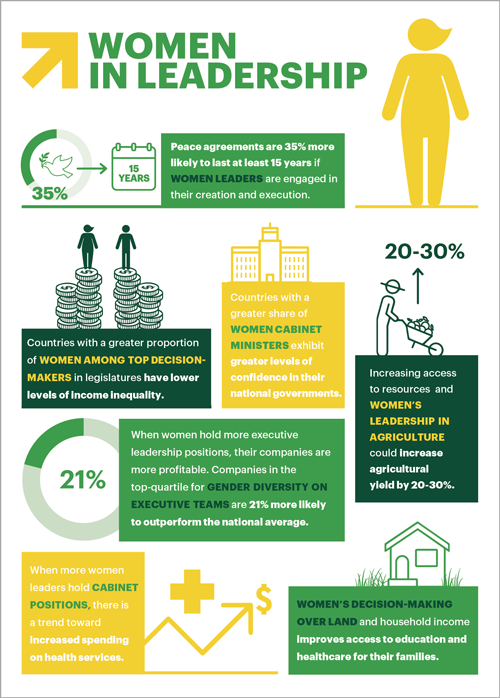Women in Leadership
It's time for the world to recognize the benefits of women in leadership, and commit to placing even more women in positions of power.
THE POWER OF WOMEN LEADERS
Women are powerful agents of change, and the far-reaching benefits of diversity and gender parity in leadership and decision-making are increasingly recognized in all spheres. Still, women continue to be vastly under-represented in decision-making in politics, businesses, and communities.
THE EVIDENCE
Women as leaders and decision-makers at all levels are critical to advancing gender justice and gender equality—and to furthering economic, social, and political progress for all.
- When women are meaningfully represented and engaged in leadership bodies—such as legislatures, courts, executive boards, community councils—laws, rulings, and decisions are more likely to be inclusive, representative, and take diverse views into account.
- Women’s leadership within households, including decision-making over land and household income, improves access to education and healthcare for their families.
- Countries with a greater proportion of women as top decision-makers in legislatures have lower levels of income inequality.
- Peace agreements are 35% more likely to last at least 15 years if women leaders are engaged in its creation and execution.
- When women hold more executive leadership positions, their companies are more profitable: companies in the top-quartile for gender diversity on executive teams are 21% more likely to outperform the national average.
French Infographic: Download Infographic
Spanish Infographic: Download Infographic
THE WAY FORWARD
The case for balancing the power equation in leadership has never been more clear: elevating women in decision-making benefits politics, businesses, and communities. But progress in women’s leadership will not happen automatically. The below actions we can take together—across governments, corporations, academia, non-profits, and civil society—to balance power in leadership and decision-making:
- Commit to gender parity in leadership.
- Implement laws and regulations that guarantee a safe and open environment for women’s participation and leadership.
- Establish policies and practices that encourage women’s leadership and promote gender parity.
- Invest in and develop public services and programs that enable women to succeed as leaders.
- Enable and support women’s organizations and movements.
- Change the narrative on women in leadership, and confront socio-cultural drivers of gender inequality.





